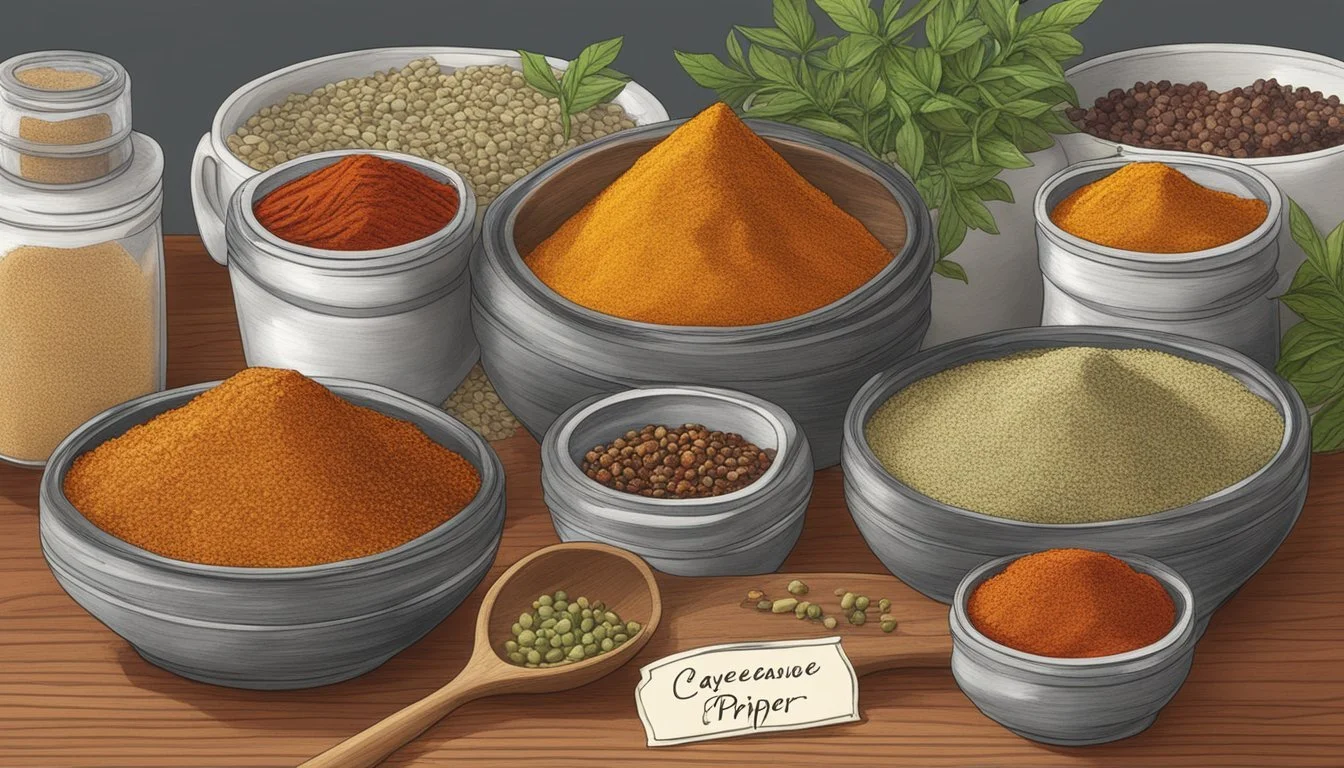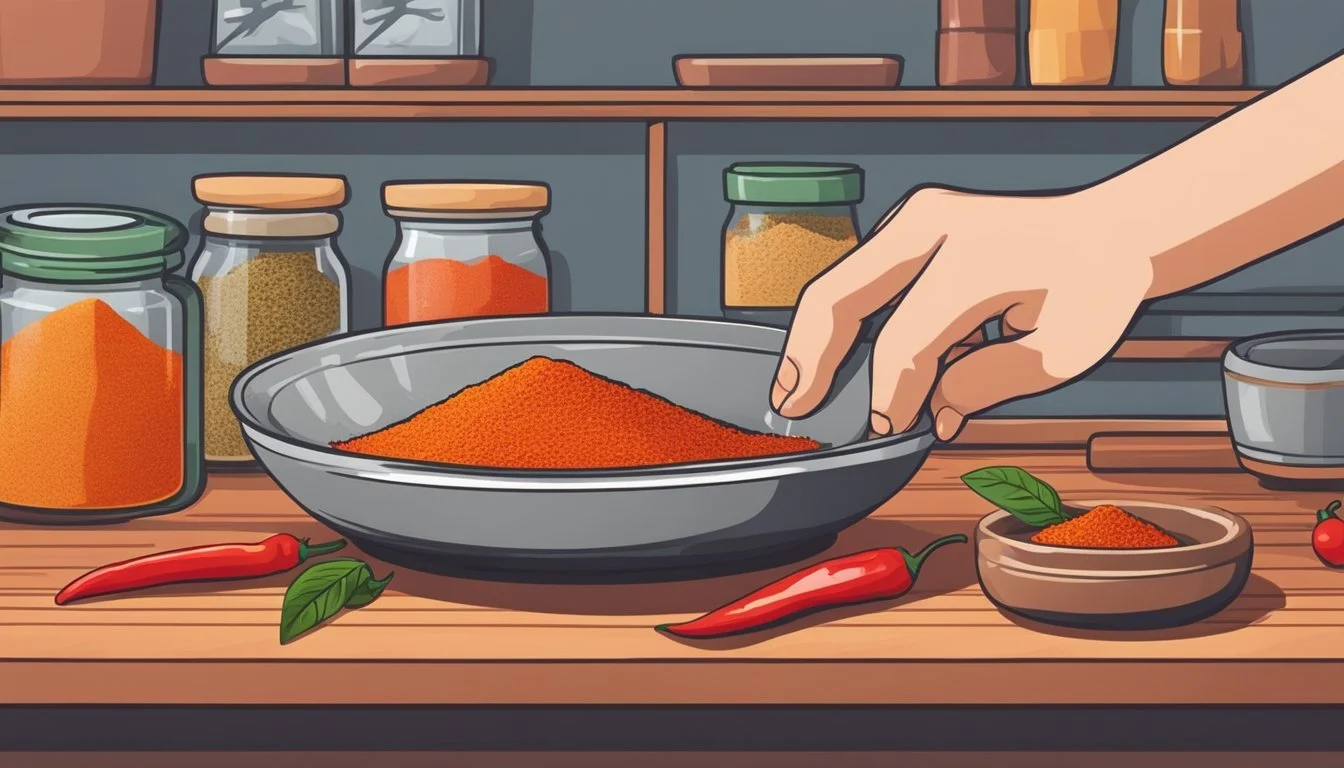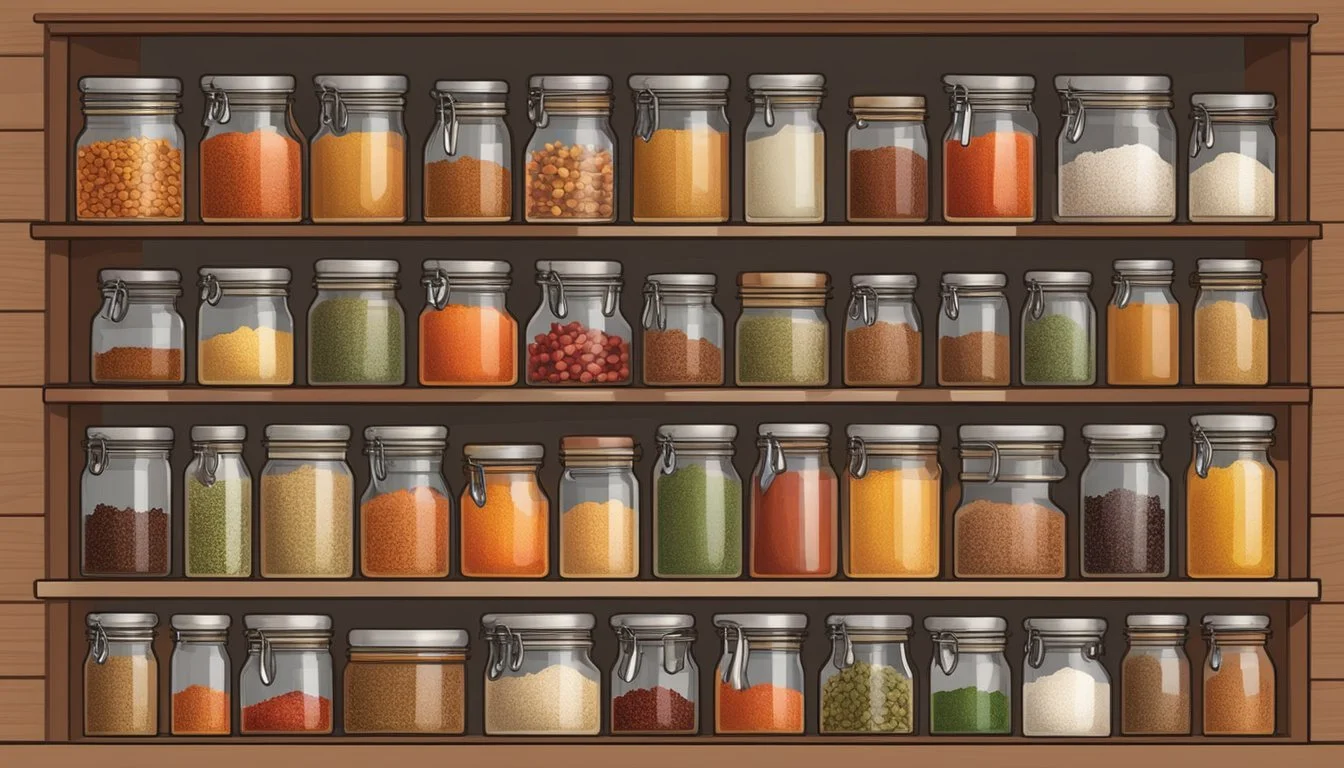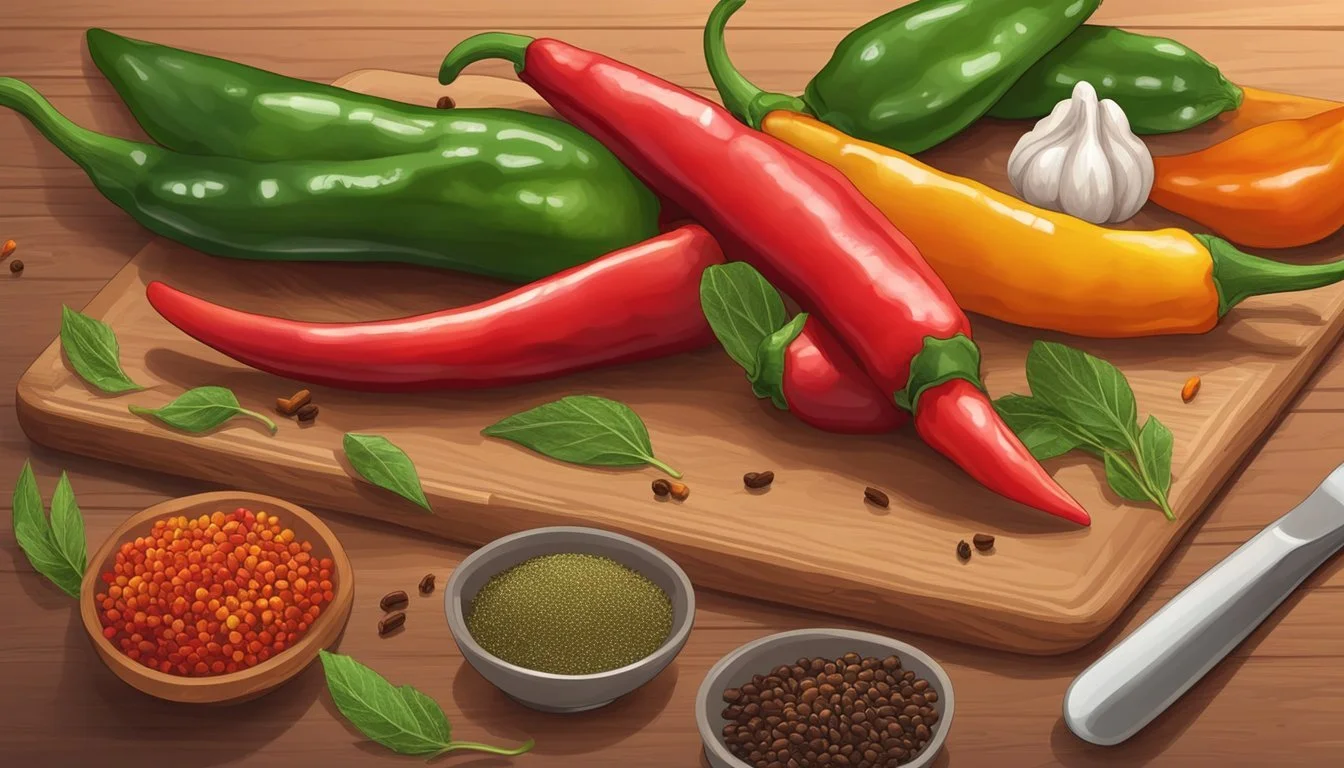Cayenne Pepper Substitutes
Top Alternatives for Spicy Cooking
Cayenne pepper is a versatile and fiery spice commonly used in a variety of cuisines to add heat and flavor to dishes. Derived from the dried pods of small, red chili peppers, cayenne pepper provides more than just a simple kick to the palate; it is a staple in kitchens for its ability to enhance the overall flavor profile of a recipe. With a heat level that is considered moderate to high, it ranks between 30,000 to 50,000 on the Scoville Heat Units scale. This spice is often employed in small amounts to season meats, stews, soups, and other savory dishes.
However, culinary adventures do not need to be halted if cayenne pepper is unavailable. Cooks can turn to several substitutes that will still allow them to create a dish with a comparable zing and taste. Substitutes like paprika can offer a similar visual appeal and texture, with a varying degree of heat based on its type, whereas options such as tabasco sauce or chili powder provide a more direct match in terms of heat. When selecting a cayenne pepper alternative, it's important to consider the heat intensity and flavor profile of the substitute to ensure that it complements the dish appropriately.
Understanding Cayenne Pepper
Cayenne pepper holds a prominent position in the culinary world, not just for its heat but also for its health benefits and bold flavor. This section explores the characteristics and heat level of cayenne pepper within the Scoville Scale.
Cayenne Pepper Profile
Cayenne pepper, coming from the Capsicum annuum species, is a red, hot chili pepper frequently used to flavor dishes. Typically, the peppers are dried and then ground, crushed, or pulsed into a fine powder. It's known for its bright red color and is commonly found in its dried powder form in most kitchens. Cayenne pepper is not only cherished for its spicy kick but also for the depth of flavor it can add to any dish.
Heat Level and Scoville Scale
The heat of cayenne pepper is measured in Scoville Heat Units (SHU), which quantify the spice's capsaicin content, the chemical responsible for its pungency. On the Scoville Scale, cayenne pepper typically ranges from 30,000 to 50,000 SHU, classifying it as a moderately hot pepper. This level of heat is substantial but not overpowering, making cayenne a versatile chili in various cuisines.
Scoville Heat Units Pepper Comparison 0 SHU Bell Pepper 30,000 - 50,000 SHU Cayenne Pepper 100,000+ SHU Habanero Pepper
It's important to note the SHU of cayenne when considering it for recipes or when seeking substitutes, to achieve a balanced level of spiciness in dishes.
Substitutes for Cayenne Pepper
When cayenne pepper is unavailable or too spicy, several alternatives can help mimic its heat and flavor. Each substitute has its unique properties, making them suitable for different dishes and preference levels of spiciness.
Paprika Varieties
Paprika, though generally milder, offers a similar characteristic hue to cayenne. It is made from ground bell and chili peppers, providing a sweet and smoky flavor profile. For a closer heat match, Hungarian hot paprika or Spanish smoked paprika can be used interchangeably with cayenne pepper on a 1-to-1 basis.
Chili Powder as a Substitute
Chili powder is a blend containing ground chili peppers and other spices such as garlic powder, cumin, and onion powder. It offers a complex, savory flavor while being less spicy. To substitute for cayenne, one might start with equal amounts and adjust to taste, considering the additional flavors within the powder.
Using Red Pepper Flakes
Crushed red pepper flakes can be an effective cayenne pepper alternative for adding visible specks of heat to a dish. Typically, red pepper flakes are less potent, so one may need to increase the quantity slightly. The ratio is commonly 1 ½ times the amount of cayenne called for in the recipe.
Hot Sauce Variations
For recipes that benefit from a liquid component, different types of hot sauce can serve as a cayenne substitute. Tabasco sauce particularly stands out due to its similar heat range (30,000 to 50,000 SHU). One would utilize the hot sauce in the same quantity as the cayenne pepper to match the desired spiciness levels.
Other Pepper Alternatives
When a recipe calls for cayenne and it's not available, various other peppers can provide the heat and flavor needed. Both fresh and dried alternatives offer versatility for culinary substitutions.
Fresh Pepper Options
Serrano Peppers: A suitable fresh substitute, serrano peppers supply a considerable amount of heat, more so than jalapeños. They're easily used in salsas, marinades, and sauces.
Jalapeño Peppers: Milder compared to serranos, these can be added for a gentler kick and are commonly found in grocery stores.
Thai Peppers: Known for their fiery heat, they should be used sparingly to not overwhelm a dish. Thai peppers bring an authentic piquancy to Southeast Asian recipes.
Dried and Ground Pepper Alternatives
Chili Powder: Mixed with other spices, chili powder imparts a distinct but less intense heat than cayenne.
Black Pepper: Universally available, black pepper offers a milder heat and is easy to adjust according to taste preferences.
Chipotle Powder: With a smoky profile, it provides a richness while delivering a heat level that's easier to moderate.
Chile de Arbol Powder: This offers a heat and flavor profile similar to cayenne but with an added subtle smokiness.
By considering the specific heat levels and flavor profiles, cooks can seamlessly adapt recipes needing a cayenne pepper substitute. Fresh peppers such as serrano and jalapeño offer vibrant flavors, while selections like chipotle powder or chili powder maintain the dish's intended complexity with varying degrees of warmth.
Using Spices as Cayenne Substitutes
When a recipe calls for cayenne pepper and one doesn’t have it on hand, various single spices and spice blend alternatives can bring comparable heat and flavor to the dish.
Single Spice Alternatives
For recipes that require the distinctive kick of cayenne pepper, single spice alternatives can be a straightforward solution.
Paprika: Often available in kitchens, it offers a similar appearance and texture to cayenne. Varieties like hot paprika can provide a closer match in terms of heat.
Spice Heat Level Flavor Note Hot Paprika Mild Slightly sweet with a kick Smoked Paprika Mild Smoky, with less heat
Cumin: While not hot, cumin lends an earthy flavor that complements spicy profiles well. Use sparingly to avoid overpowering the dish.
Combining Spices for Heat
To mimic both the heat and complexity of cayenne pepper, one can combine multiple spices.
Spice Blends: Certain premade blends, like blackened seasoning, contain a variety of spices that together can approximate the heat and flavor profile of cayenne.
Spice Blend Components Flavor Profile Blackened Seasoning Paprika, garlic powder, thyme Earthy, spicy, with a savory note
Using a Spice Grinder: For an ideal blend, one can add whole dried chilies to a spice grinder with other whole spices to tailor the heat level and flavor balance to one's preference.
Considering the Dish
When selecting a substitute for cayenne pepper, it's essential to consider the type of dish and the role the spice plays within it. Each culinary creation has unique requirements, necessitating a thoughtful choice to achieve the desired flavor profile and heat level.
Substitutes in Soups and Stews
In soups and stews, replacing cayenne pepper requires a balance between flavor and heat. Paprika is a suitable alternative for adding color and mild flavor without the intensity. For a sharper note, dried mustard powder can be employed, providing a cleaner heat that doesn't linger. Smoked paprika could be an excellent choice for adding both a touch of heat and a smoky flavor.
Alternatives for Marinades and Rubs
When preparing marinades and rubs for meats like chicken, one might use chili powder or chipotle powder to substitute for cayenne, giving a comparable heat with added complexity. Gochugaru, a Korean red pepper flake with a sweet note, can be especially effective in Asian-inspired marinades, whereas cumin might add an earthy tone to dishes without significantly increasing spiciness.
Replacing Cayenne in Sauces
Sauces benefit from the dynamic quality of heat and aroma. A cayenne substitute here must complement the other ingredients without overwhelming them. Chili flakes provide a consistent heat that can be adjusted to preference, making them an adaptable choice for sauces ranging from pasta to pizza toppings. Meanwhile, hot sauce can be used in measured doses to fine-tune the desired heat and introduce additional tanginess.
Adapting the Heat in Baking
In baking, spices directly influence the outcome, from flavor to color. Cayenne can be left out or substituted with a milder form of chili to adjust the recipe's heat, such as ancho chili powder for a more nuanced, fruity profile. Spices like ground ginger or cinnamon can offer warmth and complexity in spiced baked goods like casseroles or sweet breads without adding spiciness.
Understanding Heat Preferences
When selecting a cayenne pepper substitute, understanding individual heat preferences and the desired flavor profile is imperative, as it directly impacts the overall satisfaction with the spiciness of food.
Adjusting the Heat to Taste
Individuals have distinct thresholds for what they consider spicy. Capsaicin is the compound that causes the sensation of heat, and its concentration varies among different chili peppers, measured in Scoville Heat Units (SHU). Cayenne pepper typically ranges from 30,000 to 50,000 SHU. When adjusting the heat to one's taste, the aim is to find a balance that accommodates the diner's spicy food tolerance while still providing the intended experience of the dish. Therefore, understanding the SHU of available substitutes is crucial.
Substitute Heat Level (SHU) Flavor Notes Red Chili Flakes 15,000 - 30,000 More texture, moderate heat Chili Powder Varies (often milder) Blend with spices like cumin Paprika 500 - 1,500 Smoky flavor, less intense heat Gochugaru 4,000 - 8,000 Vibrant color, smoky undertones
Substitutes should be utilized in a manner that recognizes their heat level and flavor notes, allowing for fine-tuning the spiciness without compromising the dish's integrity.
Recipes That Demand Specific Heats
Certain recipes may require a precise level of heat to achieve the desired result. For example, dishes that hail from cuisines known for their spicy food profile, such as Mexican or Indian cuisines, often rely on a specific heat level to retain authenticity. A chef may opt for a substitute like red chili flakes for a dish that requires a moderate spice level without overwhelming heat. Alternatively, a recipe featuring bold spices might be better served by a milder heat source, allowing the complexity of flavors to shine through. It's essential to consider these nuances to ensure that the heat substitute chosen aligns with the recipe's demands.
Preparation and Storage Tips
Proper preparation and storage are crucial to maintaining the potency and flavor of spices, particularly when dealing with substitutes for cayenne pepper such as ground chili peppers.
Grinding and Preparing Spices
When substituting for cayenne pepper with dried chili peppers, one can use a blender or spice grinder to achieve the desired consistency. If one is using fresh cayenne peppers, they should first be dried using a dehydrator or an oven set to a low temperature. Dried cayenne can then be ground into powder. To ensure even drying, peppers should be cut in consistent sizes.
Storing Spices for Freshness
To preserve their freshness and potency, ground spices, including ground chili peppers, should be stored in airtight containers away from direct sunlight and heat. A pantry or a spice rack in a cool, dark place is ideal. It is imperative one labels the containers with the date of grinding to monitor freshness. Typically, ground spices retain their flavor for up to six months, while whole dried cayenne or other dried chili peppers can last up to a year if stored properly.
Health Benefits and Uses
In discussing health benefits and uses of cayenne pepper, its application in health remedies and its significance in global cuisines are notable. The spice is derived from dried, ground peppers of the Capsicum annuum species.
Cayenne in Health Remedies
Cayenne pepper has been traditionally used in health remedies, often for its reputed ability to boost circulation and aid in digestion. Capsicum annuum, the source of cayenne powder, contains capsaicin which is thought to have analgesic properties, making it a component in some topical pain relief creams. Containing vitamin A among other nutrients, it plays a role in maintaining healthy skin and vision.
In detox beverages like detox lemon water, cayenne powder is sometimes added for its thermogenic properties, which are said to increase metabolism and aid in weight loss. However, one should approach such claims with caution, as scientific evidence is mixed.
Cayenne's Role in World Cuisines
Cayenne pepper's influence in world cuisines is vast. It is a crucial ingredient in Asian cuisine, often found in the form of ground cayenne or fresh peppers adding heat to dishes such as tandoori chicken. Its bold flavor complements the zesty profiles contributed by ginger and mustard, common ingredients in many Asian recipes.
In Cajun seasoning, prominent in the culinary landscape of French Guiana and Louisiana, cayenne pepper is a staple. It works in harmony with other spices to create complex flavors that are central to the identity of Cajun dishes. The spice's versatility is also evident in its ability to adapt to various cooking techniques, from grilling to stewing.
Frequently Asked Questions
This section addresses common inquiries regarding the substitution of cayenne pepper, focusing on measurements for substitution and considerations for those with allergies or dietary restrictions.
Substitute Measurements
When replacing cayenne pepper in a recipe, individuals often question how much of an alternative spice they should use. This typically depends on the substitute's heat level compared to cayenne. Here is a guideline for common cayenne substitutes:
Cumin: Since cumin is less spicy, start with a 1:1 ratio and adjust to taste.
Paprika: Begin with a 1:1 ratio if using sweet paprika. For hotter varieties, adjust according to your heat preference.
Red Chili Flakes: Use a 3/4 teaspoon for every teaspoon of cayenne to achieve a similar heat profile.
Chili Powder: As it is milder but flavorful, start with a 1:1 ratio and adjust to taste.
When using these substitutes, remember that a pinch typically equates to 1/16 of a teaspoon, which can be useful for fine-tuning the flavor.
Allergy and Dietary Considerations
For individuals with pepper allergies or those adhering to specific dietary guidelines, it is crucial to select a cayenne pepper alternative that aligns with their health needs.
Bell Pepper Powder: Made from dehydrated bell peppers, this is an excellent choice for those with nightshade allergies wanting a pepper flavor without the heat or allergens.
Zucchini: For texture without spice, grated zucchini can be a creative substitute, especially for those seeking nightshade-free alternatives.
Those with allergies should read labels carefully, as spice blends may contain a variety of ingredients, including allergens or additives that do not align with certain dietary requirements.







